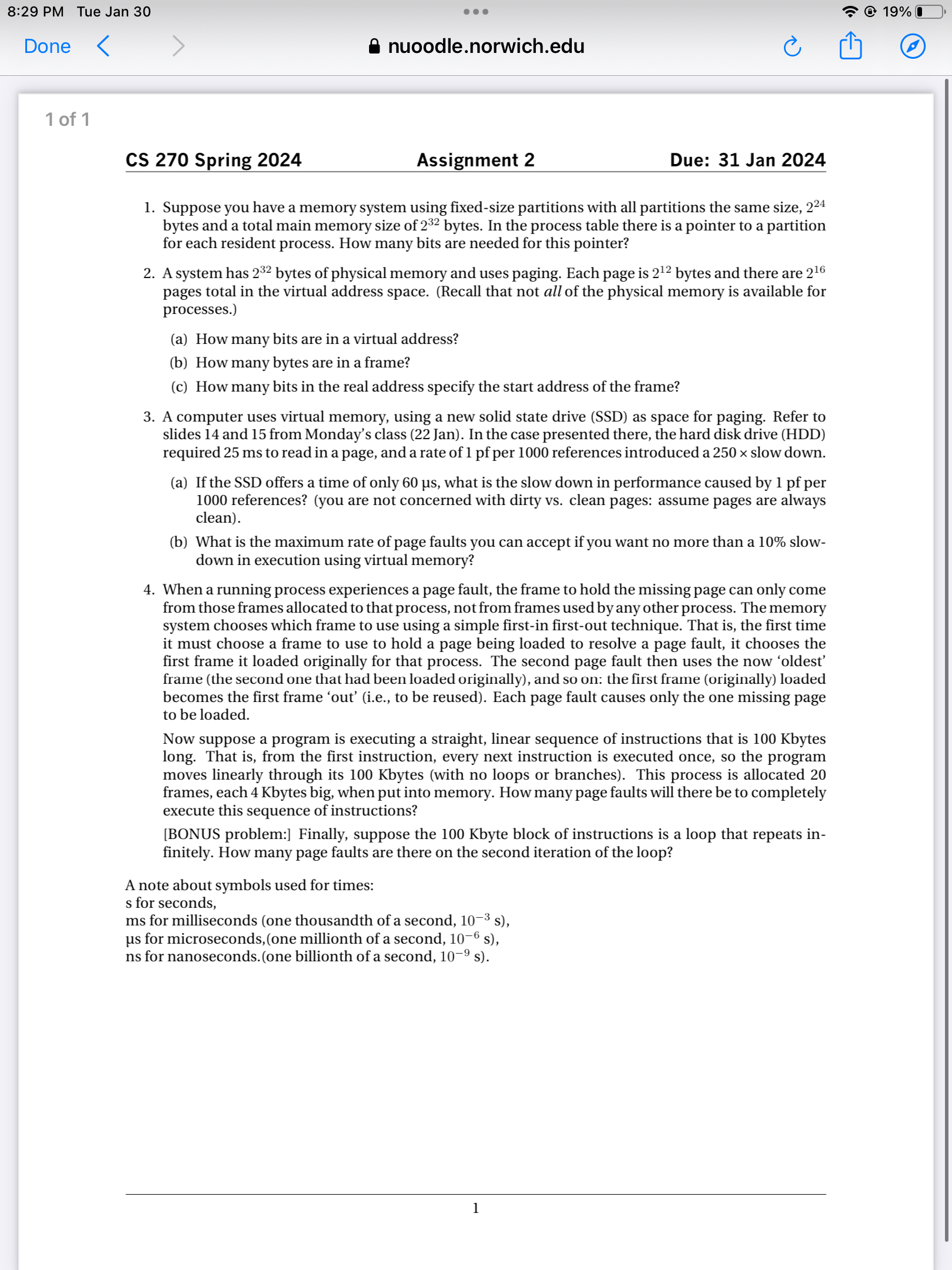Answered step by step
Verified Expert Solution
Question
1 Approved Answer
8:29 PM Tue Jan 30 Done 1 of 1 nuoodle.norwich.edu CS 270 Spring 2024 Assignment 2 1. Suppose you have a memory system using

8:29 PM Tue Jan 30 Done 1 of 1 nuoodle.norwich.edu CS 270 Spring 2024 Assignment 2 1. Suppose you have a memory system using fixed-size partitions with all partitions the same size, 224 bytes and a total main memory size of 22 bytes. In the process table there is a pointer to a partition for each resident process. How many bits are needed for this pointer? 2. A system has 232 bytes of physical memory and uses paging. Each page is 22 bytes and there are 26 pages total in the virtual address space. (Recall that not all of the physical memory is available for processes.) (a) How many bits are in a virtual address? (b) How many bytes are in a frame? (c) How many bits in the real address specify the start address of the frame? Due: 31 Jan 2024 3. A computer uses virtual memory, using a new solid state drive (SSD) as space for paging. Refer to slides 14 and 15 from Monday's class (22 Jan). In the case presented there, the hard disk drive (HDD) required 25 ms to read in a page, and a rate of 1 pf per 1000 references introduced a 250 slow down. (a) If the SSD offers a time of only 60 s, what is the slow down in performance caused by 1 pf per 1000 references? (you are not concerned with dirty vs. clean pages: assume pages are always clean). (b) What is the maximum rate of page faults you can accept if you want no more than a 10% slow- down in execution using virtual memory? 4. When a running process experiences a page fault, the frame to hold the missing page can only come from those frames allocated to that process, not from frames used by any other process. The memory system chooses which frame to use using a simple first-in first-out technique. That is, the first time it must choose a frame to use to hold a page being loaded to resolve a page fault, it chooses the first frame it loaded originally for that process. The second page fault then uses the now 'oldest' frame (the second one that had been loaded originally), and so on: the first frame (originally) loaded becomes the first frame out' (i.e., to be reused). Each page fault causes only the one missing page to be loaded. A note about symbols used for times: s for seconds, Now suppose a program is executing a straight, linear sequence of instructions that is 100 Kbytes long. That is, from the firs instruction, every next instruction is executed once, so the program moves linearly through its 100 Kbytes (with no loops or branches). This process is allocated 20 frames, each 4 Kbytes big, when put into memory. How many page faults will there be to completely execute this sequence of instructions? [BONUS problem:] Finally, suppose the 100 Kbyte block of instructions is a loop that repeats in- finitely. How many page faults are there on the second iteration of the loop? ms for milliseconds (one thousandth of a second, 10- s), us for microseconds, (one millionth of a second, 10-6 s), ns for nanoseconds. (one billionth of a second, 10- s). 1 @ 19% 0
Step by Step Solution
There are 3 Steps involved in it
Step: 1

Get Instant Access to Expert-Tailored Solutions
See step-by-step solutions with expert insights and AI powered tools for academic success
Step: 2

Step: 3

Ace Your Homework with AI
Get the answers you need in no time with our AI-driven, step-by-step assistance
Get Started


